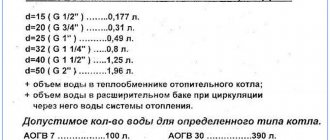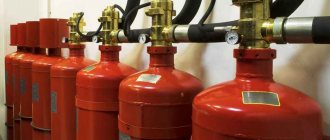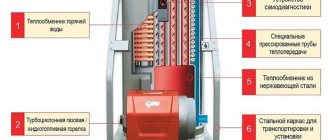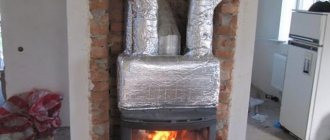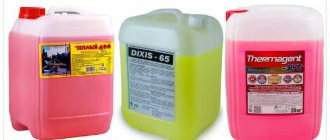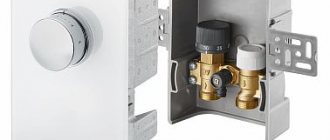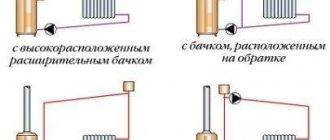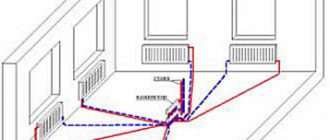How to add antifreeze to your home heating system
A country house or dacha, where the owners come to relax on weekends, is heated periodically during the winter. Therefore, the question of whether to pour antifreeze or water into the heating system of such a home is not subject to discussion. To prevent defrosting of equipment and pipes, they must be filled only with non-freezing liquid.
| Monday | Open 24 hours |
| Tuesday | Open 24 hours |
| Wednesday | Open 24 hours |
| Thursday | Open 24 hours |
| Friday | Open 24 hours Now open |
| Saturday | Open 24 hours |
| Sunday | Open 24 hours |
Restrictions on the use of antifreeze in heating supply
Damage to heating elements of electric boilers due to incorrectly selected antifreeze fluid
Despite all its positive aspects, not every antifreeze fluid is suitable for heating boilers. Improper use can lead to gradual destruction of the heat exchanger and rapid failure of expensive equipment.
In addition, there are a number of other restrictions that must be taken into account when using non-freezing coolant in heating systems:
- Many models of double-circuit boilers are not designed for antifreeze. It can get into the hot water supply system, which is an undesirable factor;
- Antifreeze liquid has a negative effect on galvanized surfaces. The protective layer quickly deteriorates and, as a consequence, the heating element fails;
- Since the viscosity of antifreeze is much higher than that of water, it is necessary to supplement the heating with powerful circulation pumps. The lower the critical level of freezing temperature, the greater the productivity of the pumps;
- Antifreeze replacement should be carried out strictly according to the manufacturer's recommendations. It loses its properties over time, which directly affects the performance of the heating system.
The antifreeze concentrate is diluted only with distilled water. An ordinary flow-through system is not suitable for this - a large number of third-party elements can cause an undesirable chemical reaction.
The video details the parameters for choosing antifreeze for heating systems:
How to pour antifreeze into an open system
This is exactly the case when you should buy safe propylene glycol. It's all about the open expansion tank communicating with the atmosphere. Since it is located within the house (usually in the attic), small amounts of fumes can enter the living spaces. In general, pouring antifreeze into an open system is not advisable. It is better to convert it into a closed one, from where it will not evaporate.
Replacing and filling with antifreeze
The diluted concentrate is poured through an expansion tank or make-up valve using a pump. In this case, all Mayevsky air valves installed on radiators must be open. As the tank is filled, the taps are closed, after which the coolant level is brought to approximately 1/3 of the expansion tank.
Replacing and filling with antifreeze
Advice. Before you pump antifreeze into the heating system of your home with your own hands, you need to make sure that all shut-off and control valves are open.
Replacing and filling with antifreeze
After starting and warming up the boiler, you need to bleed the air through the batteries again. If the level of heated coolant in the expansion tank has dropped, then add antifreeze to about half.
What type of antifreeze is there?
Despite the significant diversity in the range of antifreeze liquids, substances of this type are usually presented in two forms:
- Concentrates . They turn into a solid state at a temperature of -65 degrees. Before pumping into the pipes, softened or distilled water is additionally added to the concentrates.
- Ready-to-use formulations . Such antifreezes begin to freeze at -30 °C. They can be poured into the system without prior preparation.
In cases where it is necessary to save money, it is possible to dilute the finished composition, as a result of which its freezing temperature rises to -15...-20 degrees. It is not recommended to dilute antifreeze too much, because... this will significantly reduce its positive characteristics.
Antifreezes for home heating available for sale are mainly made based on the following substances:
- Ethylene glycol
. The compositions are quite inexpensive and effective, which explains their high popularity. When used, a serious limitation is the high toxicity of the liquid. Ethylene glycol antifreeze must not be poured into dual-circuit systems due to the risk of getting inside the hot water supply pipeline. The same applies to open systems (threat of toxic fumes). - Propylene glycol
. The higher cost in this case is compensated by non-toxicity and a weaker aggressive effect on seals and metal elements of the circuit. Propylene glycol liquids can be used in systems with double-circuit boilers: getting into pipes with hot water does not entail any undesirable consequences. - Antifreeze
. There is a ban on the use of antifreeze for heating systems. The reason is the too aggressive effect of this substance on all surfaces in contact with it (this provokes their rapid destruction).
Filling a closed heating system
Here, it is most convenient to carry out the filling process using a pump connected to the system’s replenishment fitting. If there is no pump, then you will have the grueling job of pouring antifreeze through the highest point by unscrewing the automatic air vent. It is also advisable that an assistant participate in the operation. Its job is to release air from the batteries while you are pumping antifreeze into the boiler room. Before starting work, make sure that:
- all shut-off valves are open;
- the boiler shut-off valves are closed;
- the concentrate is diluted according to the instructions;
- Mayevsky relief valves are closed;
- the valve shutting off the membrane expansion tank is open.
Replacing and filling with antifreeze
The process begins with pumping antifreeze until the pressure gauge shows a pressure of 1.4-1.5 bar. After this, you need to give a signal to the assistant to gradually release air from the radiators, starting with the lowest ones. At this time, you need to monitor the drop in pressure on the pressure gauge and slowly pump up the coolant so that it does not fall below 1 bar.
Note. In closed heating systems, there must be a spring-type check valve on the make-up connection, otherwise it will be difficult to pump antifreeze or water into it.
Replacing and filling with antifreeze
When all the air has been successfully released, the antifreeze is pumped back in to a pressure of 1.5 Bar. Then you need to open the valves that shut off the boiler one by one - first on the return line, and then on the supply line. Open the second tap slowly so that the air has time to escape through the automatic air vent, which is located on the boiler safety group. In this case, the pressure will begin to drop again, and you will have to immediately pump up the antifreeze.
Replacing and filling with antifreeze
When starting the heat generator and warming up the coolant, you need to monitor the pressure gauge readings. As a result, they should not exceed 1.8 Bar at operating temperature. The last stage is re-venting the air from the heating devices and adjusting the pressure. You need to work with Mayevsky taps carefully and carefully so as not to get burned or spill antifreeze, especially when you poured ethylene glycol into the system.
Advice. At the end of the process, carefully inspect all connections and equipment for antifreeze leaks.
If these are detected, it is not necessary to empty all the pipelines again; you can cut off a separate branch or radiator with fittings, and after eliminating, raise the pressure again and bleed off the air. Replacing and filling with antifreeze
Popular antifreezes for heating
Ethylene glycol-based antifreezes are divided into two categories depending on their freezing point: - 30 °C and - 65 °C.
This type is cheap and cold resistant. Antifreeze based on ethylene glycol has a significant drawback - high toxicity, which limits the conditions for its use. Ethylene glycol, which is colored red by manufacturers to warn of danger, is not used in open heating systems.
Propylene glycol, colored green by manufacturers, is safe to use. The coolant has a freezing point of 35 °C and can be used in systems with an open expansion tank.
Antifreeze made from glycerin is safe to use and has a freezing point of 30 °C. In comparison with ethylene glycol and propylene glycol, it has a number of advantages and can successfully replace them:
- protects corrosion nodes and does not damage parts and elements;
- compared to coolants based on ethylene glycol and propylene glycol, with a service life of no more than 5 years, glycerin-based antifreeze has a longer service life - up to 8 years;
- the liquid is sold in diluted form, ready for use;
Fact! Glycerin-based antifreeze can be used in heating systems as a replacement for another type of coolant, without flushing the pipes.
Heating a house 100 m²
Really, honestly, really
| Heating a house 100 m² from | RUR 49,500 |
| Installation of heating boiler | 8,000 rub. |
| Installation of heating radiators (no more than 10 pieces)!!! The cost of installing a heating radiator is ± 2,500 RUR/piece | 25,000 rub. |
| Radiator pipe routing | 12,000 rub. |
| Pressure testing and filling with coolant | 4,500 rub. |
| TOTAL turnkey: | RUB 49,500 |
| Drilling holes, rigging, dismantling, paid extra | according to_estimate |
Heating a house 100 m²
Cost of materials from 120,000 rubles
Included by type of work
| Boiler installation | Installing an electric boiler on a wall or floor |
| Installation of pipes without “grooving” | Open pipeline installation with wall or floor mounting |
| heating radiators | Mounting the heating device on the wall, installing fasteners |
| System pressure testing | Pressure testing of the assembled system with an air compressor to identify possible leaks |
| Commissioning works | Filling with coolant (antifreeze or water), removing air from the heating system during work |
| !!! No heated floors | It is calculated additionally, it requires coordination of the type of substrate for the pipes, the type of use of the pipe, the possibility of control and automatic control, and of course the footage |
| !!! Without external chimney | To calculate the cost, an engineer’s visit is required, an inspection of the roof structure, window location and much more. |
House heating
Propylene glycol
Propylene glycol is used to produce special antifreeze liquids that are used as a coolant in heating systems. In its pure form, propylene glycol has a rather low heat capacity (2400 J/kg deg). Therefore, before pumping the coolant into a closed heating system, it is diluted with water. It significantly increases the heat capacity of the substance. As a result, the solution has a heat capacity close to antifreeze (depending on the concentration - 3500-4000 J/kg deg).
Other characteristics of propylene glycol:
- high viscosity;
- low corrosion activity due to the presence of additives;
- non-toxic - the canisters with the substance are marked “Eco”;
- coefficient of thermal expansion – 0.05%/deg.
Sequence of work on installation of the heating system
Stage one
To
install radiators, you need to create a single level so that the radiators are at the same height. A laser or water level is used depending on the characteristics of the object.
Stage two
Installation of the radiator in its original place. Installation of radiator mounts, level calibration. Drilling and drilling holes for pipe routing.
Stage three
Connection (
installation ) of pipes for a heating , installation of shut-off and control valves, installation of fasteners for pipes. Installation of air removers on radiators (Mayevsky valve), as well as, if necessary, along the heating .
Stage four
Installation heating boiler at the workplace, if necessary, connection to the chimney. Installation of the necessary shut-off and measuring valves and fittings on pipes. Pressure testing of the completed work with an air compressor. Filling the heating . Start-up and commissioning works, routine commissioning tests
Rules for carrying out work to replace the coolant
For normal coolant circulation inside heating boilers and systems, it is necessary to timely replace antifreeze, which is performed in several steps:
- Stopping the system to reduce its temperature to a safe level;
- Next, the craftsmen drain the circuit - by the color and presence of impurities in the liquid, you can easily determine the degree of internal contamination;
- Before adding new antifreeze liquid, the heat exchangers and system are cleaned. If the contamination is not severe, then the best option is to use a chemical that effectively removes scale and traces of corrosion;
- Then it is washed with clean water, purged with a compressor, then new coolant is poured in and the system is brought into operating mode.
Replacing the coolant restores operating efficiency and allows you to maintain high temperatures with minimal energy consumption (gas, diesel fuel).
Why is it necessary to flush the boiler and system when replacing antifreeze?
During the operation of heating equipment, corrosion occurs in old radiators, radiators, stop valves, and pipes. Also, high temperatures contribute to the formation of deposits and scale directly on the internal surfaces of heat exchangers. There is a need to replace the fluid and clean the system. Our company, along with the chemical method, effectively uses mechanical and hydrodynamic methods. Then it is washed with water and the coolant is replaced with new antifreeze. Now you can use the system in normal mode - the recommended service life is 5 years.
Stages of installation of a heating system
In a new private house, through the general appearance of the heating , its layout and all the nuances at the stage of design and construction of the building. This way you will immediately know whether you need a separate room for the boiler room, where you can lay out technological niches for wiring system elements and installing equipment. This will significantly simplify further work and reduce installation time. In addition, if you are going to hide the pipes, then you should take care of this before the finishing work begins. It is most convenient to install the heating before the floor screed is poured.
You can begin installation work only after closing the building’s thermal circuit, that is, after installing windows and covering the roof. The season plays a big role. It is better to leave this work for the warm period of the year, since low temperatures deteriorate the quality of welding and increase the fragility of metal-plastic elements. And, of course, it is necessary to calculate the installation time so that by the beginning of the heating season the system is checked and running. This will allow you to meet the harsh Russian winter in a warm and cozy home.
House heating
The entire installation of home heating can be divided into several stages:
- system selection, design and calculation work;
- selection and purchase of materials and equipment;
- installation of a boiler room and installation of its components or installation of the boiler in another room (if the selected model allows this);
- installation of radiators;
- commissioning works.
An important issue to be resolved is the choice of heating system.
There are several of them: air, electric, open and traditional with liquid coolant. Stages of installation of a heating system
In an air system, the coolant is, as the name suggests, air that is taken from outside, heated and distributed throughout the rooms through the duct system. This is the most secure system. But it is complex and costly in terms of installation and maintenance, and also has low heat transfer.
Perhaps the most unpretentious in operation and environmentally friendly is the electric heating system . Here, the coolant can be electric convectors, autonomous oil and infrared batteries, fan heaters, and electric fireplaces. The disadvantage of such a system is obvious - high electricity bills and complete dependence on a stable supply of the latter.
In open systems, stoves and fireplaces are used for heating, in the firebox of which a fire is lit.
The efficiency of such systems is quite low, and they are suitable only for small country houses. Heating systems
liquid coolant is considered traditional , which includes a heat source (boiler), heat pipes and heating devices (radiators). At the center of the classic system is the heating boiler. You should approach your choice especially carefully, thoroughly weighing all the pros and cons of each model.
We also offer to conclude a service agreement after the work, not only for the heating boiler, but also for the entire system.
- Administrator to House water supply from a well02/12/2021
Autonomous water supply Autonomous water supply Water supply Water supply for a summer residence Water supply for a home Water supply Installation of water supply - Administrator to Heating layout in a private house02/07/2021
The layout of heating pipes in a house is of great importance, since the efficiency of the system directly depends on it. It is necessary to draw up a detailed plan with... - Administrator to Water supply installation02/07/2021
Preparation for water supply installation If you are going to install a water supply system in a private house or apartment, then you need to limit the supply… - Administrator to Water supply installation02/07/2021
Selection of pipes when installing water supply How difficult the installation of water supply and sewerage will be depends directly on the type of pipes that will be used.… - Administrator to Installation of water supply 02/07/2021
When overhauling an apartment or private house, installation of water supply will be required - the price for the service directly depends on the scope of work. If… - Administrator to Installation of cross-linked polyethylene pipes 02/07/2021
Installation of cross-linked polyethylene pipes from Rehau and other brands is carried out using the same technology. Methods may vary depending on the situation... - Administrator to Half of the radiator is cold01/20/2021
Repair and adjustment of heating systems in a private home, replacement of coolant, repair and replacement of the pump. Launch and commissioning. Troubleshooting... - Administrator for Urgent repair of boiler equipment01/20/2021
Repair of boilers, pumps, pipe replacement, pressure testing, startup work, heating startup - Administrator to Repair of private heating 01/19/2021
Elimination of a fistula on a straight section of a steel pipeline by mechanical means On a horizontal or vertical section of a solid steel pipe due to a number of factors... - Administrator to Replacement of a heating boiler from RUB 18,000 01/19/2021
Installation or replacement of a gas boiler The general requirements for the installation of all gas boilers are the following: Maintain a horizontal level. Installation is not... - Administrator to Repair of water supply in a private house01/19/2021
Frequent switching on and off of the device When a working pump periodically turns off, this does not indicate a problem - this is how the device performs... - Administrator to Repair of water supply in a private house01/19/2021
The pump works, but does not pump. It often happens that water pumping equipment connected to the network works, but does not pump water. The reason for the appearance... - Administrator to Repair of water supply in a private house01/19/2021
The pump does not work The reason for the complete inoperability of the deep-well device may be one of the following points: Repair of a water pump: main malfunctions, such as... - Administrator to Repair of water supply in a private house01/19/2021
Basic malfunctions of submersible pumps Correctly determining the cause of the malfunction will help to understand the type of device and how it works. There are two varieties... - Administrator to Welding soldering of copper pipes 01/19/2021
Autonomous heating Water heating Diesel heating Wood heating Heating installation Heating Heating cottage Heating home
You can find out how to hide heating pipes in the baseboard.
Heating cost calculation
Heating systems
Cost of repairing heating systems
Heating repair
Cost of installation of water supply
Water supply systems
LLC DESIGN PRESTIGE 8
Call
around the clock
Heating systems, water supply, sewerage, electrical installation. On our website you will find all types of our services, installation, repair, maintenance of systems
- Administrator to House water supply from a well12.02.2021
- Administrator for Heating installation in a private house02/07/2021
- Administrator for Water supply installation02/07/2021
- Administrator for Water supply installation02/07/2021
- Administrator for Water supply installation02/07/2021
- Types and properties of heat-carrying fluids
The working fluid of any water system - the coolant - is a liquid that takes a certain amount of energy from the boiler and transfers it through pipes to heating devices - radiators or underfloor heating circuits. Conclusion: the efficiency of heating depends on the physical properties of the liquid mediator - heat capacity, density, fluidity, and so on. In 95% of private houses, ordinary or treated water is used [...] - About the pros and cons of glycol antifreezes
The main advantage of artificial coolants based on glycols is the preservation of the liquid phase at subzero temperatures. Let's list other positive aspects of using antifreeze in closed water heating systems: coolants do not contain calcium and magnesium salts, which form scale inside heat exchangers; Thanks to the penetrating ability of glycols, the effect of lubrication of moving parts occurs, ball valves and thermostatic valves do not sour, the fittings […] - New mineral coolants
We decided to highlight the description of these liquids, since they are made on the basis of the natural mineral - bischofite. The substance is a magnesium salt of hydrochloric acid, the full name is magnesium chloride hexahydrate. The manufacturer declares the following characteristics of the finished antifreeze, designed for a minimum temperature of minus 30 degrees: the color of the aqueous solution is light yellow, the density is 1117...1250 kg/m³; boiling threshold - 116 °C, [...] - Choosing an “anti-freeze agent” for heating
Tip number one: buy and fill in antifreeze only in extreme cases - for periodic heating of remote country houses, garages or buildings under construction. Try to use water - regular and distilled, this is the least troublesome option. When choosing a frost-resistant coolant, follow these recommendations: If your budget is limited, take ethylene glycol from any well-known brand - “Teply Dom”, Dixis, […] - About coolants for electrode boilers
Electric water heaters of this type operate on the principle of a “soldier’s boiler” of two blades connected to a 220 volt network. Water simultaneously serves as a coolant and electrolyte; heating occurs due to its conductivity, which depends on the content of magnesium and calcium salts. This is why electrode boilers do not work with distillate and significantly lose power with under-salted water. According to the passport of the Galan heater, [...] - Propylene glycol in the heating system
Green solution, food additive E1520, used in the cosmetics industry. Pour point -50°C. 3 times more viscous and 2 times more expensive than ethylene glycol. It is used in buildings where there is a risk of the system defrosting, but compliance with environmental characteristics is required. We use propylene glycol in recuperators of restaurant ventilation systems. In our country, propylene glycol for the heating system […] - Instructions for using antifreeze
If your system previously ran on water, switching to antifreeze will not be easy. Theoretically, radiators with a boiler can be emptied and filled with cold-resistant coolant, but in practice the following will happen: due to the lower heat capacity, the output of the batteries and the efficiency of heating rooms will decrease; due to viscosity, the load on the pump will increase, coolant flow will drop, and less heat will reach the radiators; Antifreeze expands faster than water, [...] - Rules for preparing for the heating season of a residential building
The heating season in domestic spaces continues for a long time due to the peculiarities of the geographical location of the country. The season during which heating of buildings is required, according to SNIP 23-01-99, differs depending on the climate zone in which heat consumers live. For the northern regions, heat supply is required for more than 7 months of the year. Peculiarities of weather conditions in this […] - Replacing heating antifreeze
Replacing heating antifreeze Design Prestige Company offers services in the installation market… - Replacing antifreeze
► Replacing antifreeze ◄ In recent years, antifreeze has become increasingly popular... - Combined heating of a dacha with antifreeze
For many modern city residents, a dacha is not just a garden plot, but instead a place where you can take a break from the bustle of the metropolis. Houses suitable for living in winter are being built on the site. In this case, you need to take care of good heating at home so that you are comfortable all year round. To do this, you need to choose the optimal heating system. The main role here […] - Combined heating with antifreeze
When choosing a coolant for heating a home, many people ask the question: water or antifreeze? In severe winter conditions, under various circumstances, the water in the heating system can freeze and cause a lot of trouble. The best solution is combined heating with antifreeze, a non-freezing liquid. If circumstances arise that require autonomous heating of the house, such as interruptions in external power supply in winter, boilers are used […] - Combined home heating using antifreeze
Design Prestige LLC offers professional services for installation, maintenance and repair of home heating. Modern combined heating of a house using antifreeze “Autonomous heating of a house is designed to maintain the air temperature in a comfortable range. In our country with harsh winters, it is impossible to imagine a cozy home without this engineering structure. Today, liquid heating is most widespread. The advantages of this heating method over [...] - Combined heating of a cottage using antifreeze
When living in a country house all year round, it is important to foresee and plan everything at the design stage, because making any mistake can lead to irreparable consequences and costly repairs (or reconstruction) of the heating system as a whole. The choice of coolant also plays an important role. And if, with year-round living and the presence of an additional alternative source of energy, it is possible to fill the system with water, then […] - Heating with antifreeze
Heating with antifreeze Today, a significant part of heating systems still use ordinary heating fluid as a coolant... - Heating a house with antifreeze
Recently, more and more often, owners of private houses with an autonomous heating system use antifreeze as an energy source. Antifreeze is essentially... - Heating a dacha using antifreeze
Owners of private homes equipped with individual heating often face the problem of the risk of the coolant freezing during the cold season. Especially,… - Private heating using antifreeze
Heating a cottage using antifreeze. The main problem of country houses that are temporarily abandoned by their owners in the winter is the defrosting of heating pipes and… - Advantages of using antifreeze in autonomous heating
Heating a cottage with antifreeze For some, a country house is a place to relax, find peace and tranquility after the bustle of the city and hard work, and for others - - Electric heating with antifreeze
When choosing an electric boiler for heating your home, it is important to consider the type of coolant used. As a rule, this can be water or antifreeze. The choice is made taking into account several factors, the main of which are climatic... - Heating with antifreeze
In radiator-type heating systems, along with the traditional water coolant, antifreeze is often used, which is several types of non-freezing liquid. For heating... - Electric heating with antifreeze
Electric heating with antifreeze Installing heating appliances in an apartment or house is a vital norm. Without warmth there will be no coziness and comfort. A house without these two components is not attractive, but... - Heating a country house with antifreeze
Most heating systems use water as a working fluid. However, if a country house is heated sporadically, it is worth considering additional methods to prevent the coolant from freezing during periods of significant drop in outside air temperature. Methods for protecting heating from freezing There are two ways to provide protection from freezing when the house is not heated regularly and at long intervals Using an additional source […] - Water heating - replacing antifreeze / coolant
Selecting a thermal energy carrier for a water heating system is a responsible process that requires accurate calculations and high-quality… - Heating: antifreeze or water
Often, when installing heating, customers express a desire to use not ordinary water, but special antifreeze in the heating system. What is antifreeze and should it be used? This is a frost-resistant coolant intended for heating systems, which contains aqueous solutions of propylene and ethylene glycol, with the addition of various additives that correct the physical characteristics of these solutions. The main advantage of antifreeze […] - Our offers
Heating systems Private houses Enterprises Installation of heating systems Installation of ITP, central heating stations Commissioning of heating systems Commissioning of heating units Automation Dispatch Replacement of antifreeze Analysis of coolant Preparing houses for the heating season Pressure testing of heating units and systems Replacement of pump Replacement of valves, registers Replacement of expansion tank Heat supply , heating Autonomous, water, gas, private, individual, diesel, electric, wood, […]
Types of thermal media
The cheapest coolant is water.
But the use of water is not always justified. Water should be used in heating systems that are not subject to corrosion. The use of water as a heat carrier has certain reservations. Such a coolant must be processed by distillation, this will protect the heating system from the formation of scale in it. The use of water that freezes at zero temperatures can destroy pipes in the event of an emergency shutdown. Injecting special “anti-freeze” agents as a coolant allows you to ensure high-quality operation of the home heating system. The market for manufacturers of antifreeze for heating offers various types of thermal media, made on different bases and having certain characteristics, on which their final price depends.
Basic requirements for a coolant:
- The degree of viscosity of the thermal fluid with temperature changes;
- Inertness of antifreeze in relation to other materials;
- The thermal fluid must not be corrosive and be safe for residents in terms of toxicity and ignition;
- Thermal conductivity of the material;
- The price of the thermal fluid must correspond to its payback period.
Urgent plumbing services
The specialization of our company is the provision of plumbing services of the highest quality with excellent service and a mandatory guarantee for the work performed. For many years, we have been performing plumbing work of any level of complexity both in apartments and in the private sector. We have a team of highly qualified plumbers with extensive experience in this industry. Working for ten years, we have learned to find the right solution even in the most difficult situations.
We provide the following plumbing services to our clients:
- Installation and dismantling of plumbing systems
- Installation of any plumbing equipment (installation of a washbasin, installation of a faucet in the bathroom, installation of a faucet in the kitchen, installation of a toilet, installation of bathtubs, installation of a shower cabin, etc.)
- Installation and connection of household appliances (washing machine, dishwasher, boiler, etc.).
- Repair of plumbing equipment.
- Replacement of water supply pipes in the apartment.
- Call a plumber around the clock in Moscow and the region.
Basic principles of work of a plumber in our organization
The main principle of our work is an individual approach to everyone, because we value our clients. Our company's specialists work only with the latest equipment and use high quality materials. We are confident that only an experienced, constantly improving master is able to bear full responsibility for the work performed and guarantee high quality.
We work directly with clients and that is why we have the most favorable conditions for both parties. A flexible system of discounts applies to sanitary work. For each potential client, we provide free consultation on the selection of materials and inform on other issues of interest.
We give every client a guarantee . Thanks to this, you can be sure that our team of specialists carries out plumbing work to a high standard and in a short period of time.
The cost of installing heating systems
Heating system installation
| Heating radiator installation | PC | from 2,000 ₽ |
| Installation of a floor-mounted convector | PC | from 4,500 ₽ |
| Installation of a heating radiator ( non-standard size, cast iron, design) | PC | from 4,500 ₽ |
| Installation of distribution heating cabinet | PC | 4 500 ₽ |
| A set of works for installing a heating system for a house up to 100 m² | from | 49 500 |
| A set of works for installing a heating system for a house up to 150 m² | from | 52 500 |
| A set of works for installing a heating system for a house up to 200 m² | from | 72 500 |
| A set of works for installing a heating system for a house up to 250 m² | from | 87 500 |
| Please call for exact cost | 84957446774 |
The cost of installing heating systems . Price adjusted as of January 06, 2021
Installation of an underfloor heating system (warm floor)
| Water heated floor | m² | from 500 ₽ |
| Distribution manifold cabinet for underfloor heating (external) | PC | 4 500 ₽ |
| Heated floor temperature control device | PC | from 2 000 ₽ |
| Heated floor temperature control groups (thermostatic valve, thermostat with clamp-on sensor, bypass valve, starter) | PC | 3 750 ₽ |
| Main pipes heating system and pipe insulation (cross-linked polyethylene, metal-plastic) up to 20 mm | m/linear | 100 ₽ |
| Main pipes heating system and insulation with pipe insulation (cross-linked polyethylene, metal-plastic) up to 32 mm | m/linear | 230 ₽ |
| The exact cost is calculated after check-out | engineer |
The cost of installing heating systems . Price adjusted as of January 06, 2021
Installation of heating systems for warehouses, hangars, workshops, car service centers
| Installation of a fan heater , with pipes, fastening to a concrete wall | PC | from 15 000 ₽ |
| Installation of automatic fan heater control | PC | from 4 500 ₽ |
| Pressure testing, commissioning, filling with coolant | m2 | from 100 ₽ |
| Register mounting, thread | PC | from 6 750 ₽ |
| Register installation, welding | PC | from 15 000 ₽ |
| The exact cost is calculated after check-out | _engineer_ |
The cost of installing heating systems . Price adjusted as of January 06, 2021
- Administrator to House water supply from a well12.02.2021
- Administrator for Heating installation in a private house02/07/2021
- Administrator for Water supply installation02/07/2021
- Administrator for Water supply installation02/07/2021
- Administrator for Water supply installation02/07/2021
- Administrator for Installation of cross-linked polyethylene pipes02/07/2021
- Administrator to Half of the radiator is cold01/20/2021
- Administrator for Urgent repair of boiler equipment01/20/2021
- Administrator for Private heating repair19.01.2021
- Administrator for Heating boiler replacement from RUB 18,000 01/19/2021
- Administrator for Plumbing repair in a private house01/19/2021
- Administrator for Plumbing repair in a private house01/19/2021
- Administrator for Plumbing repair in a private house01/19/2021
- Administrator for Plumbing repair in a private house01/19/2021
- Administrator for Welding and soldering of copper pipes01/19/2021
How to replace the coolant
- Draining the heating system If necessary, dispose of the coolant at our company's warehouse if another coolant was previously filled.
Filling and discharging coolant from the system
Filling the heating circuit in a house with coolant is usually performed in the following cases:
- Initial start-up of heating in a private house.
- Bringing the heating system into working condition after planned or unforeseen repairs or replacement of the boiler, shut-off fittings, and other elements.
- Refilling before the heating period after draining the coolant from the heating system in a house that has not been heated for a long time.
To discharge the coolant, it is necessary to open special valves at the bottom of the circuit, as well as at least one valve for air intake, so that water flows freely from the system.

